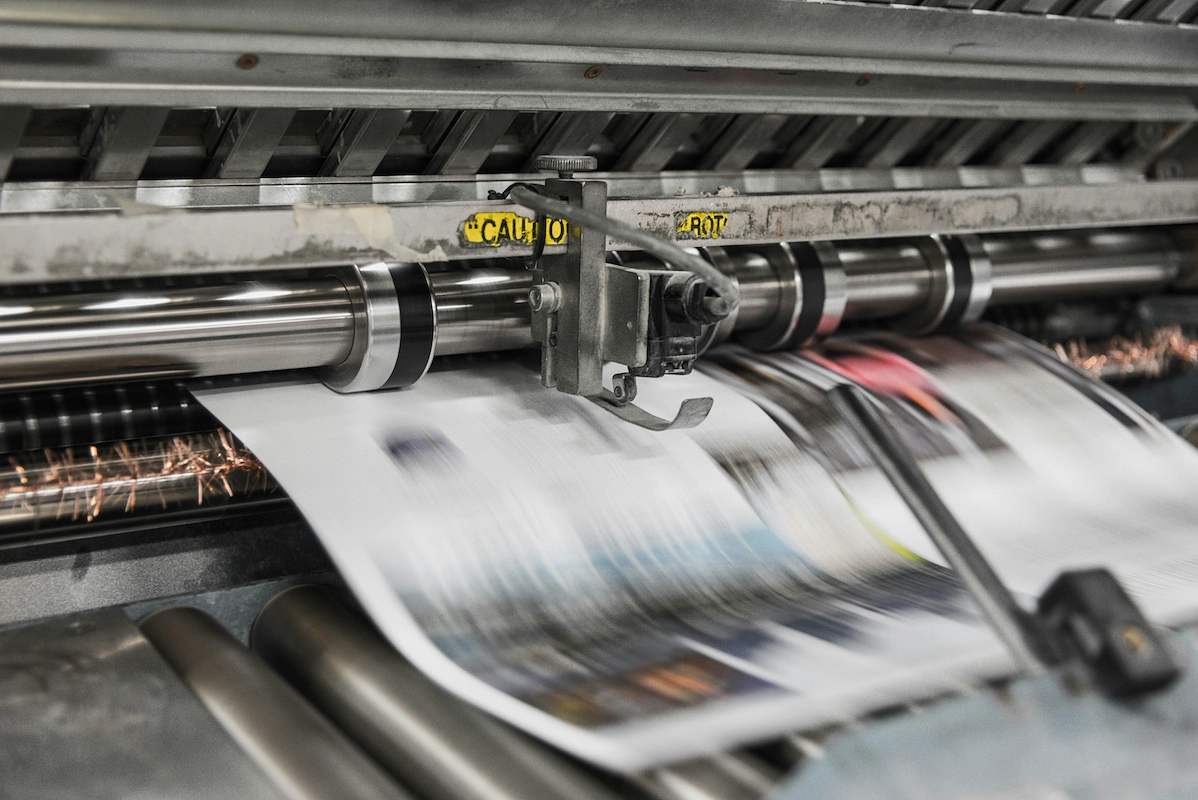Starting a yard sign business is a rewarding venture that blends creativity with business savvy. The custom sign market is a multi-billion dollar industry, fueled by consistent demand for real estate signs, political campaigns, party announcements, and local business ads.
This guide will take you through the practical steps of validating your concept, acquiring equipment, securing permits, and finding suppliers to help you launch a successful yard sign business in the U.S.
Step 1: Validate your business plan
Start by analyzing your local area. Drive through commercial and residential zones to see what types of yard signs are popular. Note the quality, size, and messaging. Also, join local business and community Facebook groups to observe demand for event and promotional signage.
Research your local market
Use Google Maps to identify all the sign shops within a 20-mile radius. Review their websites to understand their offerings, from simple one-color signs to full-color graphics. Many new owners make the mistake of only looking at national online printers and ignore their real local competition.
Estimate your startup costs
Your initial investment will vary, but you can create a solid budget. A reliable vinyl cutter is a significant part of your startup expense, so it is wise to plan for it. You might be tempted by cheaper models, but breakdowns can cost you jobs and your reputation.
Here is a typical breakdown of initial expenses:
- Vinyl Cutter (24-inch): $1,500 - $3,000
- Design Software (Adobe/CorelDRAW): $30 - $60 per month
- Initial Material Inventory (vinyl, blanks, stakes): $500 - $1,000
- Business Registration & Licenses: $100 - $400
Expect a total startup cost between $2,100 and $4,500. This does not include a dedicated workspace or vehicle, which you may already have.
Here are 3 immediate steps to take:
- Map out at least five local competitors and analyze their pricing.
- Create a detailed spreadsheet with your projected startup costs.
- Identify three potential suppliers for corrugated plastic sign blanks and H-stakes.
Step 2: Set up your legal structure and get licensed
Choose your business structure
You should consider forming a Limited Liability Company (LLC). This structure protects your personal assets, like your home and car, if the business faces a lawsuit. It is a safer route than a sole proprietorship, which offers no separation between you and the business.
An LLC also offers tax flexibility. Profits pass through to your personal tax return, which avoids the double taxation that corporations face. This simplifies your accounting at the end of the year. Many owners find this structure to be the best of both worlds.
Secure your licenses and permits
First, get a free Employer Identification Number (EIN) from the IRS website. You need this for tax purposes and to open a business bank account. The process is online and takes just a few minutes to complete.
Next, register your business name with your state’s Secretary of State. This typically costs between $50 and $200. Some new owners run into trouble by not checking local sign ordinances. Always check with your city’s zoning department before placing signs to avoid fines.
You will also need a general business license from your city or county clerk’s office. This license usually costs between $50 and $150 per year and confirms you can operate legally in your area.
Here are 3 immediate steps to take:
- File for an LLC with your state's Secretary of State.
- Apply for a free EIN on the official IRS website.
- Contact your local city clerk to ask about a general business license and sign ordinances.
Step 3: Insure your business and manage risk
Understand your coverage options
General liability insurance is your first line of defense. It covers third-party claims like property damage if a sign falls on a car. A $1 million policy is standard and typically costs between $400 and $700 per year. This is not an area to cut corners.
Next, consider commercial property insurance. This protects your expensive equipment, like the vinyl cutter and your material inventory, from theft or fire. If you use a vehicle for deliveries, you will need a commercial auto policy. Many new owners make the mistake of relying on personal auto insurance, which will not cover business-related accidents.
You might want to get quotes from providers that specialize in small businesses. Companies like Hiscox, The Hartford, and Next Insurance understand the risks for a business like yours and can offer tailored packages. Get at least three quotes to compare coverage and price.
Here are 3 immediate steps to take:
- Request a quote for a $1 million general liability policy.
- Review your vehicle use to determine if you need commercial auto insurance.
- Contact an agent from a provider like The Hartford or Hiscox to discuss a business owner's policy.
Step 4: Set up your workspace and buy equipment
You can start this business from a garage or basement. You need about 150-200 square feet for a worktable, cutter, and material storage. Before you commit, check your local zoning laws for any restrictions on home-based businesses.
If you decide to lease a commercial spot, try to negotiate for one or two months of free rent. This gives you time to set up before payments begin. Landlords are often flexible on this point, especially with longer leases.
Choose your core equipment
Your equipment is a significant part of your initial budget. Many new owners buy a cutter that is too small to handle common jobs. A 24-inch model is a solid starting point because it easily manages standard 18x24 inch sign blanks.
- Vinyl Cutter (24-inch): $1,500 - $3,000. Brands like Graphtec or Roland are industry workhorses.
- Large Worktable (4x8 feet): $200 - $500. You can also build one to save money.
- Weeding Tools & Squeegees: $50 - $100 for a quality starter set.
With equipment in mind, find your suppliers. Companies like Grimco and Montroy Sign & Graphic Products are go-to sources for vinyl, sign blanks, and stakes. Most do not have minimums for pickup orders, but delivery usually requires a $100 minimum purchase.
Here are 3 immediate steps to take:
- Measure your proposed workspace to confirm you have at least 150 square feet.
- Research prices for a 24-inch vinyl cutter from brands like Graphtec or Roland.
- Locate the nearest Grimco or Montroy branch and confirm their delivery minimums.
Step 5: Set up your payment processing
Establish your payment terms
You should require a 50% deposit before you start any work. This covers your material costs and secures the order. The remaining balance is due upon pickup or delivery. This policy protects your cash flow and filters out less serious clients.
When you choose a payment solution, look for low transaction fees and quick access to your money. Some new owners get hit with high rates, often between 2.5% and 3.5%, or have to wait days for funds to transfer. This can really slow you down.
For yard sign businesses that need to accept payments on-site or on-the-go, JIM offers a streamlined solution. With JIM, you can accept debit, credit, and digital wallets directly through your smartphone—just tap and done.
At just 1.99% per transaction with no hidden costs or extra hardware needed, it's particularly useful for collecting final payments on delivery. Your money is available right on your JIM card as soon as the sale is done, with no waiting for bank transfers.
Getting started is straightforward:
- Get Started: Download the JIM app for iOS.
- Make a Sale: Type the sales amount, hit sell, and ask your customer to tap their card or device on your phone.
- Access Funds: Your money is available right on your JIM card as soon as the sale is done.
Here are 3 immediate steps to take:
- Decide on your deposit policy, such as 50% upfront.
- Download the JIM app to see how it works for your business.
- Add your payment terms to your standard customer quote template.
Step 6: Fund your business and manage finances
Most yard sign businesses do not need large bank loans. You might consider an SBA Microloan, which offers up to $50,000. The average loan is about $13,000 with interest rates between 8% and 13%. These are great for equipment and initial inventory purchases.
Another option is a business credit card with a 0% introductory APR. This lets you buy materials and pay them off over 12-18 months without interest. Be sure to pay the balance before the promotional period ends to avoid high rates.
Plan your working capital
A mistake some owners make is focusing only on the initial equipment purchase, leaving little cash for the first few months of operation. You should have enough cash to cover at least three to six months of expenses. This gives you a buffer before sales become consistent.
Your working capital should cover recurring costs. Plan for about $500-$1,000 per month for vinyl, sign blanks, software subscriptions, and a small marketing budget. This ensures you can take on jobs without waiting for customer deposits to clear.
Here are 3 immediate steps to take:
- Research SBA Microloan lenders in your area on the SBA website.
- Compare two business credit cards that offer a 0% introductory APR.
- Create a spreadsheet to project your first six months of operating expenses.
Step 7: Build your team and manage operations
In the beginning, you will be the sole operator. A single person can typically handle up to $80,000 in annual revenue. Once you consistently hit $5,000 in monthly sales, you might want to consider hiring part-time help to keep up with demand.
Hire a production assistant
Your first hire should be a Production Assistant. This person will handle weeding vinyl, applying graphics, and assembling signs. The most important trait is a keen eye for detail. Mistakes in production directly impact your reputation and your bottom line.
Expect to pay an hourly wage between $15 and $20, based on your local market. No formal certifications are required for this role. You will train them on your specific equipment and process, so prioritize candidates who are reliable and quick to learn.
Set up your workflow
To prevent orders from slipping through the cracks, use a project management system. A free platform like Trello is perfect for creating a visual workflow. You can set up columns for "New Orders," "In Production," and "Ready for Pickup" to track each job's status.
Here are 3 immediate steps to take:
- Draft a job description for a part-time Production Assistant.
- Set a monthly revenue target that will trigger your first hire.
- Create a free Trello board to organize and track your orders.
Step 8: Market your business and find customers
Start by creating a free Google Business Profile. Fully complete your profile with photos of your work, your hours, and your service area. This is how local customers will find you when they search for "yard signs near me." Aim to get five-star reviews from your first few clients.
Build your initial client base
Use Facebook Marketplace to advertise signs for common events like birthdays and graduations. Also, join local community and business groups on Facebook. Post photos of your work and engage with people who ask for sign recommendations. This direct visibility builds trust quickly.
You should also reach out directly to businesses that use signs constantly. Contact five local real estate agents, roofers, or landscapers. Offer them a 10% discount on their first order to get your foot in the door. Repeat business from these clients can become your foundation.
Many new owners make the mistake of only competing on price. Instead, compete on speed and reliability. Offering a 24-hour turnaround for simple, one-color signs will win you more jobs than a small discount. Clients often need signs fast and will pay for that service.
Here are 3 immediate steps to take:
- Set up and optimize your Google Business Profile with photos of your work.
- Join three local community Facebook groups and post examples of your signs.
- Create a list of five local real estate agents to contact with an introductory offer.
Step 9: Set your pricing strategy
Calculate your cost of goods
First, figure out your cost for each sign. Add up the price of the sign blank, the vinyl used, and the transfer tape. For example, a blank might cost $2, with another $2.50 in vinyl and tape. Your total material cost is $4.50.
Next, factor in your labor. If a simple sign takes you 15 minutes to make and you value your time at $20 per hour, that is $5 in labor. Your total cost of goods sold (COGS) for that one sign is now $9.50.
Price for profit
With your costs clear, you can set your price. A standard approach is to apply a 300% to 400% markup on your material costs. For a sign with $4.50 in materials, a 300% markup is $13.50. Add your $5 labor cost to get a final price of $18.50.
Many new owners fall into the trap of a price war. Instead of just being the cheapest, compete on value. Offer a 24-hour turnaround for an extra fee or provide free design mockups. Clients will pay more for speed and service.
Here are 3 immediate steps to take:
- Calculate the total material and labor cost for one standard 18x24 inch sign.
- Call three local competitors to get a price quote for a single-color sign.
- Create a price sheet for your top three sign types, including bulk discounts.
Step 10: Maintain quality and scale your operations
Establish your quality standards
Your reputation depends on consistent work. Create a final inspection checklist for every order. Before a sign leaves your shop, confirm the vinyl is straight, colors match the proof, and there are no bubbles or wrinkles. A mistake many new owners make is rushing jobs and letting small errors slide.
Know when to scale
Once you consistently hit $5,000 in monthly sales, it is time to hire part-time help. When you reach $7,500 per month, you should consider buying a second vinyl cutter to double your output. Avoid expanding too fast, as it can strain your cash flow before sales catch up.
As your client list grows, a simple spreadsheet will not be enough. You might want to use a free CRM like HubSpot to track customer orders and communication. For finances, software like QuickBooks Self-Employed helps manage income and expenses as your business becomes more complex.
Here are 3 immediate steps to take:
- Create a quality control checklist to inspect every sign before delivery.
- Set a monthly revenue goal that will trigger your next equipment purchase.
- Sign up for a free HubSpot account to start organizing your customer data.
You now have a clear path to start your yard sign business. A key thing to remember is that speed often beats the lowest price. Quick turnarounds on simple signs will build your reputation fast. You have what it takes to make this work.
And when you make those first sales, getting paid should be simple. JIM lets you accept cards right on your phone for a flat 1.99% fee, with no extra hardware. Your money is available instantly. Download JIM and you are set.















